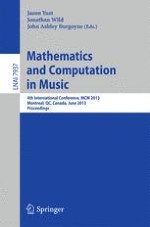2013 | Book
Mathematics and Computation in Music
4th International Conference, MCM 2013, Montreal, QC, Canada, June 12-14, 2013. Proceedings
Editors: Jason Yust, Jonathan Wild, John Ashley Burgoyne
Publisher: Springer Berlin Heidelberg
Book Series : Lecture Notes in Computer Science

